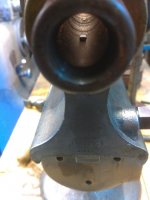I have replaced a few collet keys in various watchmaker lathes and I think I did one in a Cataract spindle. I have installed several similar keys in Hardinge lever collet closer spindle caps, which are of similar configuration. My recollection is that the spindle key is rectangular, and longer than the diameter of the cylindrical portion, so it has to be installed from inside the spindle. The outer portion of the key hole in the spindle is square, probably filed before hardening.
I make the replacement key from unhardened drill rod (silver steel in the UK). I make the cylindrical portion a very close sliding fit in the spindle hole and leave it long enough to protrude above the journal. The key has to be inserted from inside the spindle bore, which is why you don't want a press fit.
To prepare, I select a solid body collet shaped arbor (male center or Morse taper adapter, for instance) rather than a thin-walled collet because it will have to take a pounding. I make sure the keyway depth is normal for that collet and then make a narrow steel shim to fill the gap between the bottom of the collet keyway and the new key. The shim is bent down the back of the arbor to keep it in place. I make a trial installation of the key and arbor to make sure the key fits and the shim holds the key firmly against the bore of the spindle. Then I put a drop of Loctite on the key and reinstall the key, shim and arbor. I use a cross pein hammer to rivet the key into the corners of the square. Then I remove the arbor and wash out the excess Loctite from around the key inside the spindle. I use a fine file to make the top of the key flush or below the journal, polish it and call it done.
Larry
























